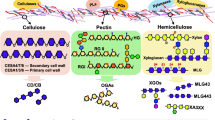Abstract
Reviews by Vance et al. (1980) and Friend (1981) contain details of and references to the earlier work on lignification in both cucumber and grasses that is briefly described below.
The suggestion of Hijwegen in 1963 that active lignification could be a general resistance mechanism in plants arose from experiments in which it was found that lignin deposition was associated with the reaction of a resistant cultivar of cucumber to inoculation withCladosporium cucumerimum. More recently Hammerschmidt and Kuć (1982) have found that systemic resistance of cucumber, induced by pre-inoculation with eitherC. cucumerimum orColletotrichum lagenarium, was associated with the ability of the induced plants to produce lignin rapidly in response to a challenge inoculation with either fungus. They concluded that induced resistance may be similar to cultivar resistance. Hammerschmidt et al. (1982) also showed that induction inoculation gave enhanced peroxidase activity in protected plants, associated with the fast-moving anodic isoenzymes.
Lignification, especially the formation of lignified papillae, seems to be a common reaction of grass plants to attempted infection by nonpathogens. This has been found in reed canary-grass,Phalaris arundinacea, and a range of grasses by Vance and Sherwood, and in wheat by Ride. In reed canary-grass, active lignification is associated with increases in the enzymes of phenolic acid biosynthesis, and in peroxidase with the appearance of one new isoenzyme. The inducible resistance response, together with the associated increases in enzyme levels, were inhibited by the protein synthesis inhibitor, cycloheximide.
The difference in response of wounded wheat leaves to inoculation by the nonpathogenBotrytis cinerea and the pathogenSeptoria nodorum appears to be related to the speed of lignification. It was rapid in the former case, confining the fungus to the wounded area; in the latter, it was slower and the fungus was not restricted.
Recent experiments indicate that the accumulation of phenolic compounds in cell walls is a major factor in the non-race-specific resistance of potato tuber discs toPhytophthora infestans and of the same cultivars toPhoma exigua var foveata (Ampomah, 1983; Ampomah and Friend, in preparation). Accumulation of these compounds, estimated either by the level of browning of discs or the intensity of blue-green staining with toluidine blue of the walls of the top layer of cells, was greater following inoculation of resistant than of susceptible cultivars. Treatment of discs with aminooxyacetic acid (AOA), which is an inhibitor of PAL activity in vivo, inhibited the deposition of the phenolic compounds and permitted the fungi to grow further through tuber tissue.
After freezing the discs in liquid nitrogen and extracting with chloroform: methanol: water (CMW), the residue was extracted with phenol: acetic acid:water (PAW). The CMW extracts contained chlorogenic acid; its level was lower in inoculated than uninoculated tissue. δεi measurements indicated that phenolic compounds were present both in the dialyzed PAW extract and in the PAW residue. There was always more phenolic material in both extract and residue from the inoculated discs of both resistant and susceptible cultivars than from uninoculated discs; the levels were always higher in the resistant than in the susceptible discs.
The presence of quinic acid in the PAW extracts indicates the possibility that they contain oxidized, polymerized chlorogenic acid. Such material is absent from the PAW residue that contains esterified hydroxy cinnamic acids. We are, as yet, unable to determine whether these acids are esterified to lignin, to carbohydrate, or to the hydroxy-aliphatic acids in suberin.
Similar content being viewed by others
References
Ampomah, Y. A. (1983), Aspects of phenolic metabolism in the potato in response to challenge byPhytophthora infestans andPhoma exigua var.foveata. PhD. thesis, University of Hull.
Friend, J. (1981), Plant Phenolics, Lignification and Plant Disease, inProgress in Phytochemistry, L. Reinhold, J. B. Harborne, and T. Swain, eds.,7, Pergamon, Oxford, pp. 197–261.
Hammerschmidt, R., Nuckles, E. M., and Kuć, J. (1982),Physiol. Plant Pathol. 20, 73.
Vance, C. P., Kirk, T. K., and Sherwood, R. T. (1980),Ann. Rev. Phytopathol. 18, 259.
Author information
Authors and Affiliations
Rights and permissions
About this article
Cite this article
Friend, J. The role of lignification in the resistance of plants to attack by pathogens. Appl Biochem Biotechnol 9, 325–326 (1984). https://doi.org/10.1007/BF02798958
Issue Date:
DOI: https://doi.org/10.1007/BF02798958




